From the rulebook: “As a prestigious city planner, you have been ordered by the queen herself to build a harmonious city. Take care to balance the human and natural realms by creating equal amounts of building (black) and park (green) tiles, and do not forget to incorporate the shape of a rectangle — the shape most important for fortification. Can you build a city worthy of the queen?”
In the strictest sense of the word, the name Tangram City is a bit of a misnomer. According to the Oxford English Dictionary, a tangram is defined as “a Chinese geometric puzzle consisting of a square cut into seven pieces that can be arranged to make various other shapes.” In Tangram City, the shapes you’ll be working with are closer to tiny triangles that have been fused together to create polyomino-like shapes, some with their corners missing.
So, just understand, you won’t be creating tangrams in this game. Instead, as the name implies, you’re going to be using these shapes to create your city and score points.
A Round of Play
During setup, each player will receive their own City board as well as a complete set of 23 City tiles (green on one side and black on the other) and 6 Fountain tiles. They’ll also place a score marker onto the Scoring board. Then, the deck of 23 cards is shuffled and set face down on the table.

At the start of a round, depending on player count, each player may receive a face down card of their own, or one which they will be sharing with a neighbor. There will always be one card face up in the center of the table. In this way, everyone has exactly two of the four pieces of information that will be disseminated in the coming round—the card in their hand and the card in the center of the table—but there will always be two unknowns.
The game is played over a series of six rounds, with four cards being revealed one by one, in player order, for the first five. In the sixth round, there will always be three cards left. They will be flipped face up for all to see, and players may work with them in an order of their choosing.
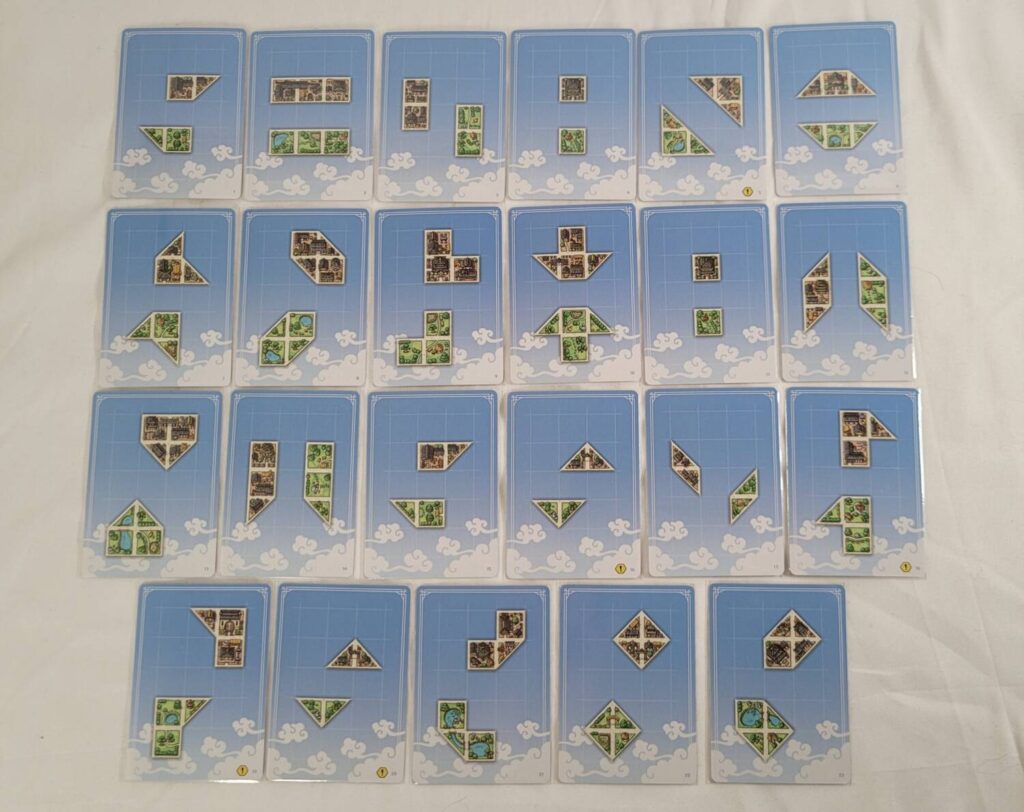
Once the cards have been dealt, the round begins. First, the players locate the tile matching the one shown on the face up card in the center of the table, and then they optionally add that tile to their board. You’re never forced to add a tile and can decide to forgo it, but that tile will never show up again for the remainder of the game. Then, the start player reveals their card, and that tile gets added (or not). This is repeated for the remaining two cards.
Once all four cards have been revealed and the players have placed everything that they want to place, the round ends and interim scoring is performed.
Scoring and Balancing
Players will count up every square in their largest rectangle and score a point for each of those squares. For instance, if your largest rectangle is 7 squares tall and 3 squares wide, you’d earn 21 points (7 times 3). Then, the players determine their current balance status.
The concept of maintaining balance is a central theme in Tangram City. Ideally, at the end of the game, you’d want there to be just as many green squares on your board as there are black squares; the more balanced you are, the more bonus points you’ll score. If you’re perfectly in balance, you’ll earn an extra 20 points. If you’re only 1 or 2 away, you’ll earn 10. If you’re 3 to 5 away, you’ll earn 5. And, if you’re more than 5 points away, you get zero bonus points. Also, if you’ve somehow managed to fill every space on your board (a feat which I have yet to see happen), you’ll score an additional 15 points.
The player with the highest score at the end of the game wins.
Thoughts
Uwe Rosenberg is a designer with many facets. One of the things that I really appreciate about him as a designer is the way that he’s able to produce such large, sweeping masterpieces like Agricola and Hallertau, but also produce much smaller, lighter fare that’s equally as challenging and engaging. His most well-known examples of “big games on a small scale” are Patchwork and his breakout hit, Bohnanza. I have no doubt that Tangram City is destined for the same level of fame.
There were a lot of games that came out of Essen last year that I was excited about, but this was my most-anticipated one, even more so than Uwe’s other big release, Planta Nubo. When it finally arrived on my doorstep, I wasted no time in getting it to the table. My excitement was palpable. When I first sat down to play Tangram City, I only had a vague notion of what to expect. You can only learn so much about a game from reading the rule book and watching videos. To really understand the way that a game ticks, you’ve got to roll up your sleeves and actually play it.
Tangram City is a very easy game to teach. It only took a few short minutes for me to convey the game’s concepts and mechanisms to my wife before we were off to the races. Having played more than my fair share of Uwe Rosenberg’s designs, I knew to expect a challenge. I just didn’t know that this game was going to be as challenging as it is.
I have likened Tangram City to what might happen if you crossed Reiner Knizia’s My City with Uwe’s Patchwork spin-off Patchwork Doodle. Like My City, Tangram City is a tile-laying game that is driven by a deck of cards that dictates what each player must play on their turn. Like Patchwork Doodle, the players are not only challenged by trying to make the pieces fit into their tableau, but they are also trying to fit them together in such a way as to create large rectangles for better scoring opportunities.
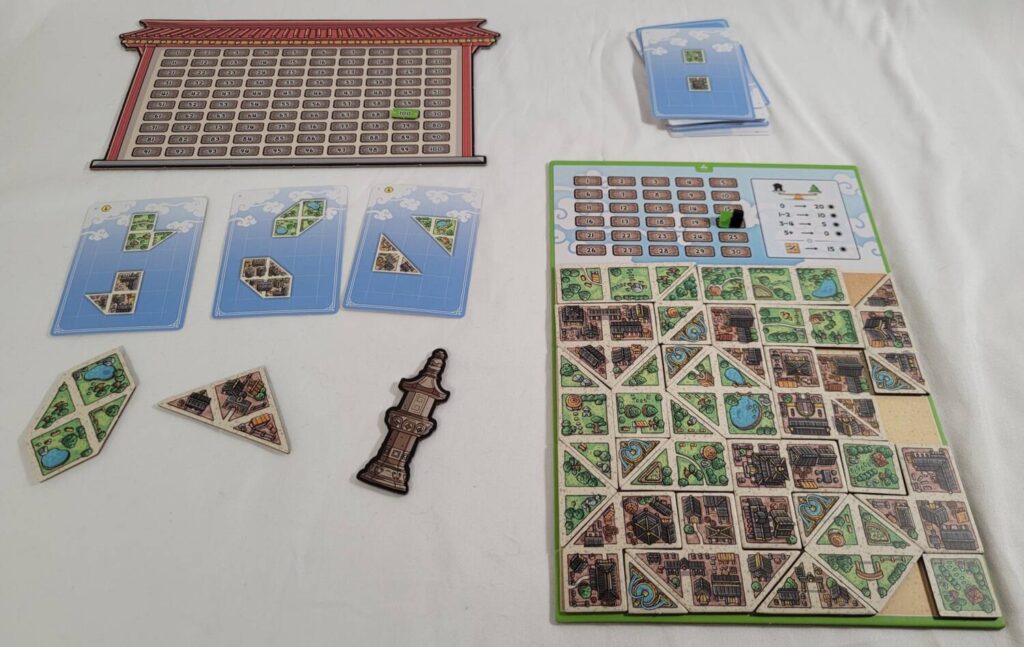
If that was all there was to it, Tangram City wouldn’t be as impressive as it is. It would be little more than a Patchwork clone played with different shapes. What really sets Tangram City apart are two little ingenious innovations.
Unlike My City where each card flipped is a complete surprise, in Tangram City, you’ll always know a secret piece of the puzzle. Having that little bit of knowledge makes it easier for you to add to your tableau. If you know exactly which piece you’ll be adding, you can build around that, leaving a hole that you know you’ll be filling in on your turn. It may not seem like much, but it’s a huge boon. And there’s an interesting side effect to the existence of hidden information floating around out there.
Knowing what’s coming up when nobody else does not only gives you some agency over what happens to you, but it also has the effect of making you pay attention to what everyone else is doing. They also have a hidden piece of the puzzle and, if you’re paying attention, you can sometimes suss out which piece of the puzzle they are holding, too. Extremely clever players will be aware of the fact that their preparations are telegraphing their hidden information and may decide to telegraph false information instead to try to fake out their opponents.
It isn’t enough to just place pieces to fill up your tableau. You’ve also got to keep balance in mind. This is the second innovation.
Finding and maintaining a balance between the green and the black is worth a hefty amount of points at the end of the game. What makes maintaining this balance particularly challenging is that flipping a piece over, to gain access to the squares of the color you need, transforms the shape’s geography. As such, you’ll often find yourself having to make a tough choice between filling in space versus sacrificing spaces in lieu of maintaining balance.
Of course, you could just forgo trying to maintain balance entirely, focusing on filling in spaces instead. It’s a viable strategy. The fact that balance is so strongly present in both theme and mechanics, but there isn’t a harsh penalty for forgoing it entirely is the only negative I can think of when it comes to Tangram City. Then again, Uwe Rosenberg is well known for punishing players for not hitting certain breakpoints (like forgetting to feed your Vikings in A Feast For Odin, for example), and this puts off a lot of people from playing more of his games. So maybe this weakness could be considered a strength instead. No harsh punishments here, folks!
Tangram City is a game that brings me joy. It lives in my backpack and sees frequent play wherever I go, and I am always excited for the opportunity to share that joy with others. In my humble opinion, it’s one of the best games that Uwe Rosenberg has ever made.
Tangram City is so good, in fact, that I find it baffling that it didn’t even receive a nomination for the coveted Spiel des Jahres. It’s got everything you’d expect from an SdJ award-winning game: family friendly theme, easy rules set, challenging game play, a pleasing table presence, and a breezy play time. Will Uwe ever win an SdJ or is he going to be like Leonardo di Caprio with the Oscars, snubbed for decades before finally being given his due? I certainly hope it doesn’t come to that.




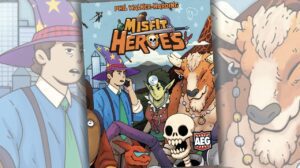

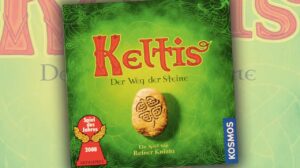
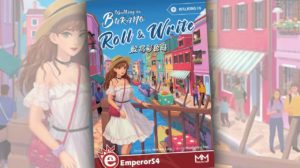




I cannot wait to play my copy. Great write up!